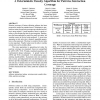Free Online Productivity Tools
i2Speak
i2Symbol
i2OCR
iTex2Img
iWeb2Print
iWeb2Shot
i2Type
iPdf2Split
iPdf2Merge
i2Bopomofo
i2Arabic
i2Style
i2Image
i2PDF
iLatex2Rtf
Sci2ools
118
Voted
IASTEDSE
2004
2004
A deterministic density algorithm for pairwise interaction coverage
Pairwise coverage of factors affecting software has been proposed to screen for potential errors. Techniques to generate test suites for pairwise coverage are evaluated according to many criteria. A small number of tests is a main criterion, as this dictates the time for test execution. Randomness has been exploited to search for small test suites, but variation occurs in the test suite produced. A worst-case guarantee on test suite size is desired; repeatable generation is often necessary. The time to construct the test suite is also important. Finally, testers must be able to include certain tests, and to exclude others. The main approaches to generating test suites for pairwise coverage are examined; these are exemplified by AETG, IPO, TCG, TConfig, simulated annealing, and combinatorial design techniques. A greedy variant of AETG and TCG is developed. It is deterministic, guaranteeing reproducibility. It generates only one candidate test at a time, providing faster test suite deve...
Related Content
| Added | 31 Oct 2010 |
| Updated | 31 Oct 2010 |
| Type | Conference |
| Year | 2004 |
| Where | IASTEDSE |
| Authors | Charles J. Colbourn, Myra B. Cohen, Renée Turban |
Comments (0)

